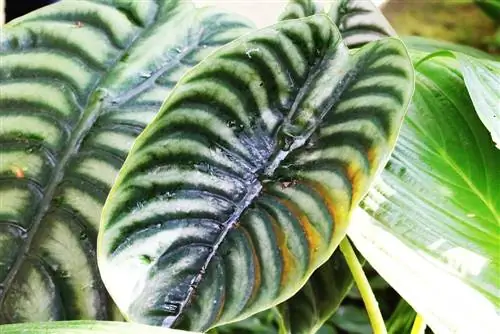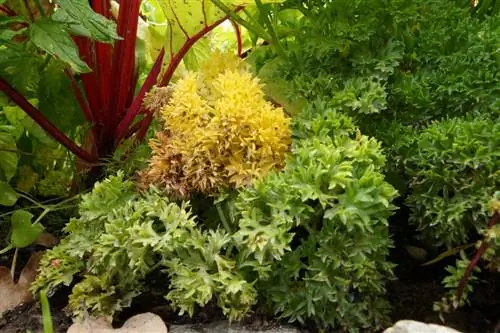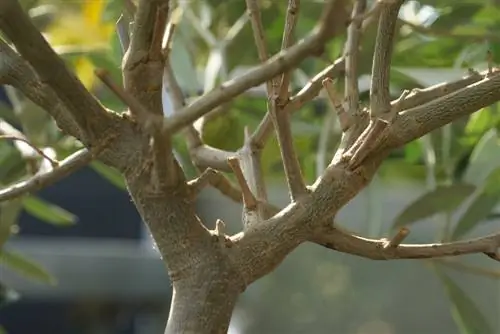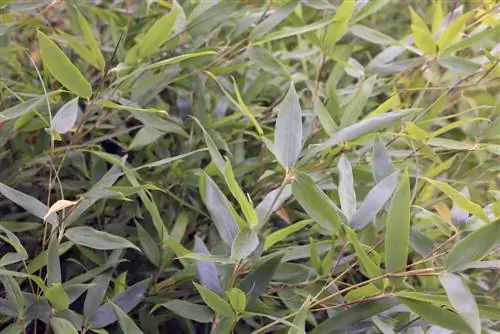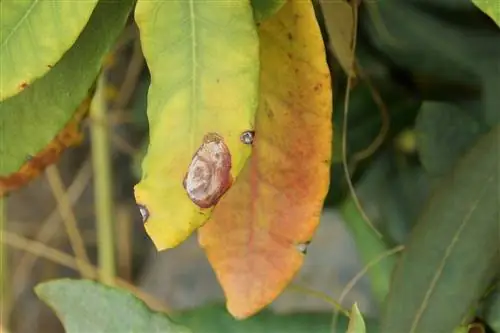- Author admin [email protected].
- Public 2023-12-17 03:39.
- Last modified 2025-01-24 12:45.
These extravagant tropical plants are among the most beautiful foliage plants and are an eye-catcher in every living room, winter garden or on the windowsill. Its attractive stalked leaves grow larger over the years. They can be completely green or have a white-green pattern. The rather rare white flower heads show their relationship to the arum family.
Care instructions
The care of these very elegant plants is a little more complex than that of most houseplants. In order to thrive optimally, they need environmental conditions similar to those in their natural habitat. This is the only way they can develop into true beauties and reveal their full splendor. There are no significant differences in care between the numerous representatives of this plant genus. The main focus is on the supply of water and the right location.
Location requirements
The elephant ear thrives best in warm, partially shaded locations with sufficient daylight and without blazing sun. After a short period of getting used to it, this plant also copes very well in completely shady locations.
- Sun is beneficial in the morning and evening
- Bright sun can quickly burn the leaves
- Location in front of an east or west-facing window recommended
- A heatable winter garden is well suited
- An outdoor location is also possible from the end of May to around September
- Choose a sheltered spot in the garden, on the balcony or terrace
- Avoid direct sunlight, drafts and temperature fluctuations
- This applies to indoor and outdoor locations
- Elephant ear needs a lot of warmth all year round
- Optimal room temperature is between 15 and 22 degrees
- The temperatures should not fall below 15 degrees, even in winter
Tip:
Since the Alocasia likes to grow in the direction of the light, it is advisable to rotate it regularly.
Soil texture
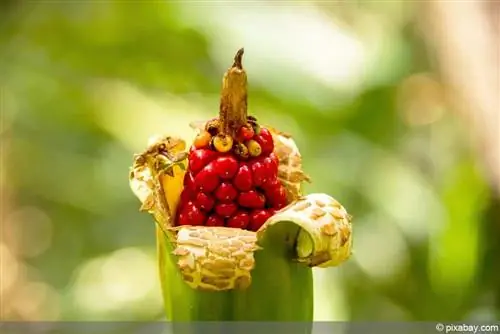
The substrate should above all be loose and slightly acidic. To do this, you can use high-quality pot plant soil with a little sand and coarse-grained components such as:B. mix fine gravel, grit, expanded clay or lava grit. The addition of cocohumer increases the structural stability of the substrate, it becomes looser and the storage capacity of water and nutrients is increased.
Another alternative is a mixture of commercial potting soil, coconut humus and clay granules or perlite. Dried coffee grounds, for example, can improve the acidic environment of the substrate. A mixture of leaf mold, peat and sphagnum moss is also suitable. Instead of leaf mold, you can also use standard standard soil to which you add a little peat.
Tip:
Peat as an admixture has the property of regulating the acidity of the soil and thus contributes to soil improvement.
Pouring
When watering, a distinction is made between soil culture and hydroculture:
Earth Culture
The water requirements of this fascinating plant are comparatively high. The substrate or bale should be evenly moist at all times. Maintaining consistently high soil moisture is particularly important in summer due to higher evaporation. However, waterlogging should be avoided at all costs as it could quickly damage the roots. Therefore, excess water in coasters and planters should always be removed quickly. The substrate should not dry out completely.
Tip:
Watering should preferably be done with soft, room temperature rainwater, or if necessary also with mineral water. Tap water containing lime is less suitable.
Hydroculture
In order to optimally supply hydroponic specimens with water without drowning them, it is advisable to use a water level indicator. It uses a scale to show when and how much water the plant needs. The less the water level indicator moves, especially with the elephant ear, the better. For hydroponics, it is usually sufficient to water once a week and in winter about once every two weeks.
Humidity
In addition to sufficient water, this attractive plant requires consistently high humidity. In their natural habitat this is over 90 percent. To achieve this, you should spray them regularly, preferably daily, with well-tempered, lime-free or low-lime water. It is also helpful to place the plant in a bowl filled with stones and water. It should not stand directly in the water.
Tip:
Optimal humidity can be achieved very well in a closed flower window or a plant display case, for example.
Fertilize
- The need for nutrients is moderately high
- Provide Arrow Leaf with fertilizer regularly from March/April to September
- Administer a high-quality liquid fertilizer via the irrigation water every 14 days
- Commercial slow-release fertilizers less suitable
- Overfertilization should be avoided at all costs
- The substrate would become acidic and damage the roots
- If in doubt, it is better to fertilize a little less than too much
Cutting
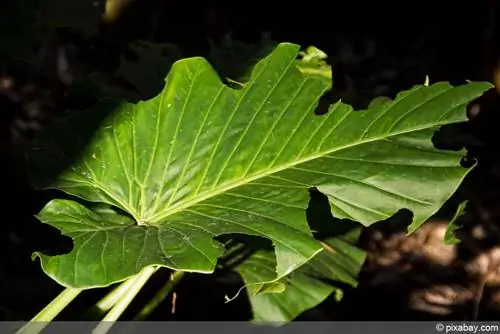
In principle, cutting these plants is not necessary and is generally not desirable. It is only advisable to occasionally clean out dry, wilted leaves. Alocasia does not have any branching, as can be achieved when pruning other plants. Yellow, unsightly leaves that naturally appear from time to time in the lower part of the plant can be easily removed at any time.
Cut out the flower
A flower in the form of a white bulb surrounded by an initially light green and later white bract is rarely seen in Alocasia. As a rule, only older and large specimens produce flowers and only under optimal conditions. If flowering actually occurs, it is recommended to cut it off. If you leave it standing, it costs the plant a lot of energy, which could cause it to die in the worst case.
Tip:
The fertilized flowers develop into bright red berries, which are very decorative, but are highly poisonous unless you cut off the flowers first.
Wintering
From around September, the elephant ear takes a break in growth. Then it should be bright, with temperatures not below 15 degrees. This plant also tolerates temperatures around 20 degrees all year round. If the winter is cooler, some of the leaves wilt and fall off. The new growth will then take place from April. Even if the water requirement is significantly lower in winter, consistent soil moisture should be maintained and the substrate should not dry out completely. There is no fertilization during this time. Only at the beginning of the growing season is a little more watered and regularly fertilized again with the first new shoots.
Repotting
Due to the vigorous growth of the Alocasia, repotting into fresh substrate and a larger planter is recommended every 2-3 years. At the latest when the roots grow out of the drainage holes or are already visible on the surface, it is time to repot.
- The best time is late winter from mid-February to the end of March
- The new planter should be big enough
- Diameter of the new pot approx. 20% larger than that of the old one
- First carefully remove the plant from the old pot
- Removing the old soil from bales
- Damage the root as little as possible
- Then equip the new pot with drainage to protect against waterlogging
- Put in some of the substrate and insert the plant
- When filling with substrate, gently shake the plant back and forth
- This is how to prevent cavities in the root area
- These could endanger the stability of the plant
- Fill the planter with soil to a few centimeters below the edge
- Press the soil lightly and water the whole thing well
Tip:
For taller planters, it is advisable to use suitable plant inserts to ensure that the roots do not come into contact with standing water.
Propagate
There are three options to choose from when propagating:
Sowing
Sowing is possible all year round. However, the seeds should be as fresh as possible, as they only remain germinable for a very short time and therefore only have a very limited shelf life. It is best to sow them immediately after purchase. Before you actually start sowing, let the seeds soak in lukewarm water for about 24 hours. Then spread them on a mixture of commercially available sowing soil and sand or perlite and cover them with a maximum of 1 cm of substrate. Cocohum is also very suitable as a growing substrate.
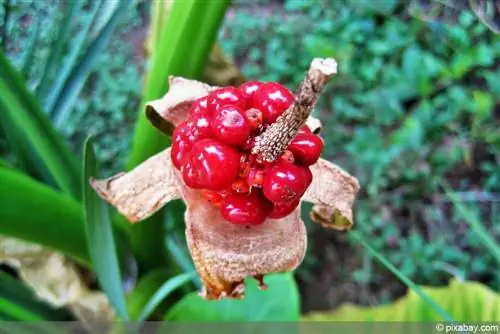
The substrate is lightly pressed and moistened. It should be constantly moist but never wet throughout the entire germination process. With a bit of luck, in a warm place at temperatures between 25 and 28 degrees, the seeds will germinate after about 3-6 weeks. Not all seeds germinate at the same time, but rather irregularly.
Division
Another, more effective way to propagate elephant ear is by dividing the rhizome. It is best to use repotting to divide the plant. After you have taken it out of the pot, divide the rhizome into individual pieces and then let them dry a little. Each of these sections should have small shoots. Now let them drive by placing them horizontally on moist peat and pulling them forward.
offshoot
From the age of around three years, an Alocasia forms so-called daughter plants that can be used very well for propagation. They should have a minimum size of 15 cm. You carefully separate them from the mother plant and put them in a mixture of sand and peat. The whole thing is moistened and placed in a protected and, above all, warm place. Conditions should remain constant until rooting is complete.
Causes of leaf discoloration
The occasional appearance of yellow leaves is a completely natural occurrence and is nothing to worry about. However, if this occurs more often, it may also have other causes, such as an unfavorable location or errors in care. Very often, too much moisture or accumulating moisture is responsible for the yellowing of leaves. This in turn can be the result of a lack of drainage or an impermeable substrate.
Even if the substrate is permanently too dry, this can lead to yellow leaves. Brown-yellow leaf tips are usually an indication of too low humidity. If, on the other hand, the leaves and their leaf veins are yellow or lightened, there may be an iron deficiency, which is often caused by a pH value that is too high orIrrigation water that is too calcareous is caused. Yellow speckles on the leaves, however, can indicate an infestation with sucking insects.
Help with yellow leaves
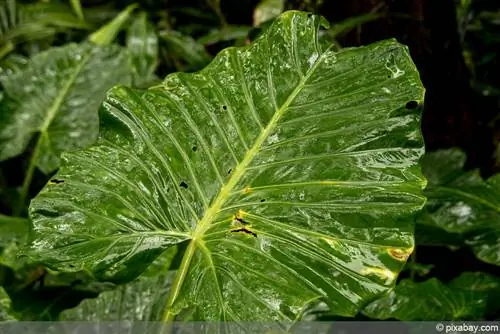
It initially promises a corresponding change of location. In addition, the watering behavior should be adapted to the needs of the plant and, if necessary, affected plants should be repotted in fresh substrate. Excess irrigation water must be removed promptly. The humidity can be increased accordingly by frequent spraying. Watering with lime-free water can counteract iron deficiency and an unfavorable pH value of the soil. If there is a pest infestation, it should be eliminated as quickly as possible.
Pests
The causes of pest infestations, for example spider mites, mealybugs or mealybugs, are often unfavorable housing conditions, especially dry heating air in the winter months. Manual removal, rinsing with room temperature water and treatment with preparations containing neem oil or paraffin oil can provide relief. In addition, the use of beneficial insects can be helpful.
What should you pay attention to when buying?
When buying an Alocasia, there are a few things you should pay attention to in order to enjoy this beautiful plant for a long time. The best time to buy is spring, so it can best get used to the new conditions. The size of the pot and the density of the plant can say a lot about the quality of the plant. The leaves should already be of an impressive size and the individual drawing should be clearly visible.
Damaged leaves as well as discoloration of the leaves or leaf edges are often the result of poor transport and storage conditions. For example, leaf spots can indicate damage caused by both cold and too much sun. In addition, you should pay attention to possible pest infestation and avoid such plants.

